![]()
![]()
![]()
Use LEFT and RIGHT arrow keys to navigate between flashcards;
Use UP and DOWN arrow keys to flip the card;
H to show hint;
A reads text to speech;
60 Cards in this Set
- Front
- Back

|
Frontalis (frontal belly of Epicranius)- Location: Forehead, Function: raises your eyebrows |
|
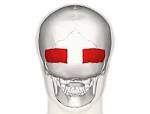
|
Occipitalis- Location: Overlying the occipital bone, Function: Pulls your scalp posteriorly |
|

|
Orbicularis Oculi- Location: The circular muscle around the eye; Function- closes your eyes |
|

|
Levator Labii Superioris- Location: Broad sheet that extends from the side of the nose to the zygomatic bone; Function: raises your lip, "Elvis Muscle" |
|
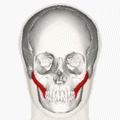
|
Zygomaticus Major- Location: Largest muscle overlying the cheekbone; Function: draws the angle of the mouth superiorly and posteriorly, "smiling muscle" |
|

|
Orbicularis Oris- Location: Circular muscle located around the mouth, Function: puckers the lips, "Duck Face Muscle" |
|
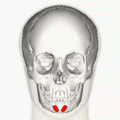
|
Mentalis- Location: Lower chin near mental foramen of the mandible; Function: upward-inward movement of the chin, "Frowning muscle" |
|
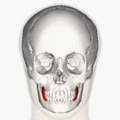
|
Buccinator- Location: forms the anterior part of the cheek or the lateral wall of the oral cavity; Function- Holds food inside of mouth during chewing, "chewing muscle" |
|
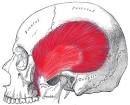
|
Temporalis- Location: Near Temporal bone; Function: elevates the mandible and closes the jaw, one of the muscles of Mastication. |
|
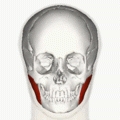
|
Masseter-Location: thick, somewhat quadrilateral muscle, consisting of two heads, superficial and deep in the jaw; Function: The most obvious muscle of mastication |
|

|
Platysma- Location: a superficial muscle that overlaps the sternocleidomastoid; Function: tenses the skin of your neck.Pee Wee Herman Muscle
|
|

|
Sternocleidomastoid- Location: a paired muscle in the superficial layers of the anterior portion of the neck; it is one of the largest and most superficial cervical muscles, Function: Rotates the head in the opposite direction |
|

|
Pectoralis Major-Location: Largest muscle of the pectoral girdle; Function: pulls chest upward, adducts and medially rotates the arm. |
|
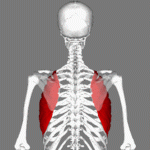
|
Serratus Anterior- Location: Underlies Pectoralis Major; Function: rotates scapula, helps anchor scapula to chest wall. |
|

|
Deltoid- Location:the muscle forming the rounded contour of the shoulder; Function- Arm Abduction |
|

|
Pectoralis Minor- Location: Deep to Pectoralis Major; Function: Draws scapula anteriorly and inferiorly |
|
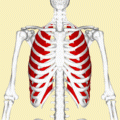
|
External Intercostals- Location:Superficial and inferior rib muscles ; Function: Elevates ribs allowing for inspiration (breathe in) |
|

|
Internal Intercostals- Location:Any of the muscles with their origin from the lower border of a rib, with insertion into the upper border of the rib below, with nerve supply from the intercostal nerve; Function: Depression of Ribcage to allow for expiration (breathe out) |
|

|
Rectus Abdominis- Location: Fibers run in parallel, paired muscle running vertically on each side of the anterior wall of the human abdomen; Function: Flexes and rotates the abdominals. |
|

|
External Oblique- Location: the largest and the most superficial (outermost) of the three flat muscles of the lateral anterior abdomen; Function: functions to pull the chest downwards and compress the abdominal cavity |
|

|
Internal Oblique- Location: the intermediate muscle of the abdomen, lying deep to (below) the external oblique and just superficial to (above) the transverse abdominal muscle. Function:helping to reduce the volume of the thoracic (chest) cavity during exhalation and rotates trunk and compresses abs. |
|
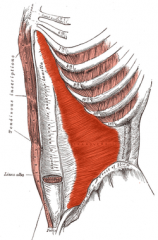
|
Transverse Abdominis- Location: a muscle layer of the anterior and lateral (front and side) abdominal wall which is deep to (layered below) the internal oblique muscle, Deepest muscle of the Abdominals; Function: Compresses/squeezes abdominal contents, helps pregnant women deliver their child |
|
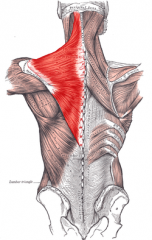
|
Trapezius- Location: a large superficial muscle that extends longitudinally from the occipital bone to the lower thoracic vertebrae and laterally to the spine of the scapula. Function: Raises, rotates, retracts the scapula. |
|
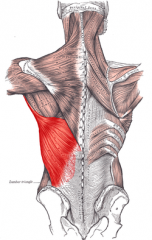
|
Latissimus Dorsi- broadest muscle of the back aka Lats; Location: the larger, flat, dorso-lateral muscle on the trunk, and partly covered by the trapezius on its median dorsal region. Function: Prime mover in arm extension and adducts. |
|

|
Infraspinatus- Location: a thick triangular muscle, one of the four muscles of the rotator cuff; Function: Lateral rotation of the humerus. |
|
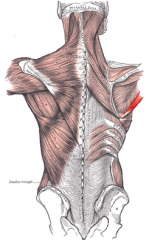
|
Teres Major: Location: is a muscle of the upper limb and inferior to the Minor; Function: Extends and adducts the humerus. |
|
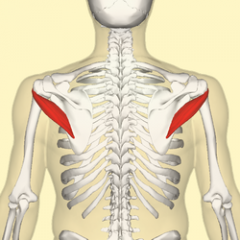
|
Teres Minor- Location: is a narrow, elongated muscle of the rotator cuff, superior to the major; Function: Lateral rotation of the humerus. |
|
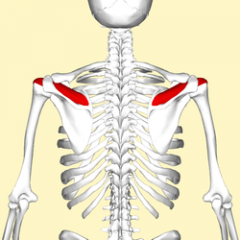
|
Supraspinatus- Location: a relatively small muscle of the upper back that runs the scapula to the greater tubercle of the humerus; Function: Abducts the humerus and helps the deltoid. |
|
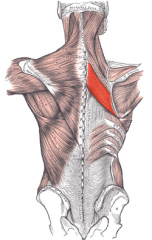
|
Rhomboid Major- Location: A skeletal muscle on the back that connects the scapula with the vertebrae of the spinal column; Function: Stabilizes Scapula (during retraction) |
|
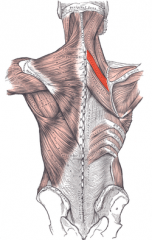
|
Rhomboid Minor- Location: a small skeletal muscle on the back that connects the scapula with the vertebrae of the spinal column; Function: Stabilizes Scapula |
|
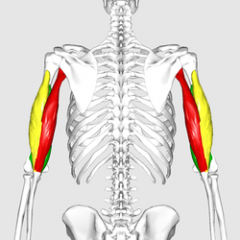
|
Triceps Brachii- Location: the large muscle on the back of the upper arm; Function: Extension of the forearm, antagonist muscle to biceps. |
|
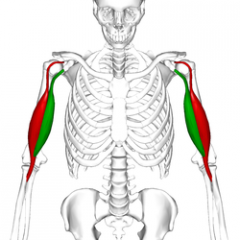
|
Biceps Brachii- Location: is a two-headed muscle that lies on the upper arm between the shoulder and the elbow; Function: Flexes the forearm, agonist muscle to the Triceps. |
|

|
Brachialis- Location: a muscle in the upper arm that flexes the elbow joint. It lies deeper than the biceps brachii; Function: Flexes the forearm and synergist to the biceps. |
|

Left anterior forearm
|
Brachioradialis- Location: is a muscle of the forearm that is attached to the distal styloid process of the radius; Function: synergist to biceps, flexes the forearm
|
|

|
Flexor Carpi Radialis- Location: Anterior and Superficial muscle of the forearm, proximal to the wrist, the most lateral (closest to the thumb) tendon visible when the wrist is brought into flexion; Function: Flexes wrist and attaches to radius. |
|
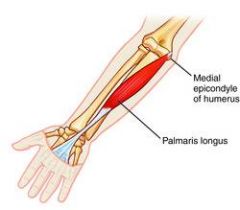
|
Palmaris Longus- Location: a small tendon between the flexor carpi radialis and the flexor carpi ulnaris, not always present; Function: tenses the skin and the facia of the palm of the hand. |
|
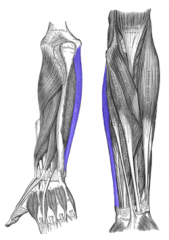
|
Flexor Carpi Ulnaris- Location: arises by two heads - humeral and ulnar; Function: Flexes the wrist and attaches to the ulna |
|
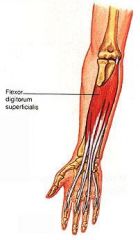
|
Flexor Digitorum Superficialis- Location: Anterior and superficial to the ulna and radius. Function: Flexes wrist to bring in the fingers |
|

|

Extensor Carpi Radialis Brevis- Location: Posterior and lateral (closer to thumb) forearm; Function: Short muscle that attaches to the radius that extends the wrist. |
|

|
Extensor Carpi Radialis Longus- Location: posterior forearm and most lateral(lines up w/ thumb) ; Function: Long muscle that attaches to the radius and extends the wrist. |
|

|
Extensor Digitorum- Location: Posterior forearm and most medial; Function: Extends the fingers |
|

|
Extensor Carpi Ulnaris- Location: Posterior Forearm and closest to the pinky; Function: muscle that attach to the ulna and extend the wrist. |
|
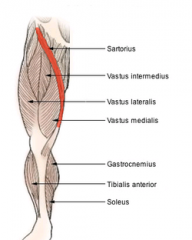
|
Sartorius- Location: Anterior long muscle of the Thigh, the S shaped superficial muscle; Function: Flexes, adducts, and rotates the thigh |
|

|
Adductor Magnus- Location: Triangular shaped, inferior ischial tuberosity to the medial femur; Function: adducts the thigh |
|
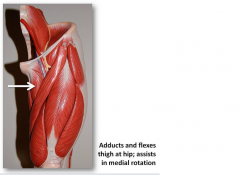
|
Adductor Longus- Location: inside of the thigh; Function: Long muscle that adducts the thigh |
|
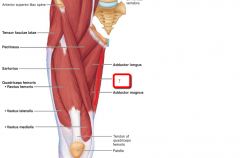
|

Gracilis- Location: the most superficial muscle on the medial side of the thigh. It is thin and flattened, broad above, narrow and tapering below; Function: Adducts the thigh |
|
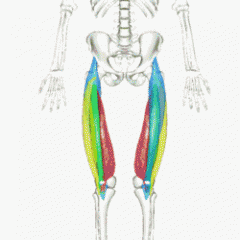
|
Quadriceps- Location: Anterior thigh; Function-Extends the knee, four muscles: Rectus Femoris- Superficial and medial (Blue), Vastus Lateralis- Deep and most lateral (yellow) , Vastus intermedius- Deep and in the middle (green) , Vastus Medial- Deep and most medial (red) |
|

|
Tensor Fasciae Latae- Location: Lateral upper thigh; Function: Steadies the trunk |
|
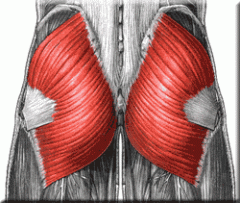
|
Gluteus Maximus- Location: Upper thigh (butt); Function: extends the thigh |
|

|
Gluteus Medius- Location: on the side of the hip and is also superficial except for the posterior portion which is deep to the maximus muscle; Function: Abducts and moves the thigh in medially. |
|
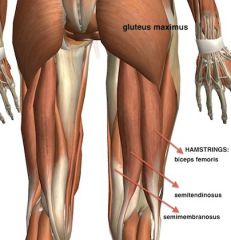
|

Hamstrings- Location: Posterior thigh muscles; Function: Flexis the knee; Composed of three muscles: Biceps femoris, Semitendinosus, and Semimembranosus. |
|
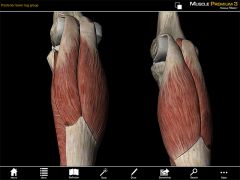
|
Triceps Surae- Location: a group of muscles in the posterior distal leg, made up of the gastrocnemius and soleus, aka the calf. Function: Plantar flexion of the foot |
|
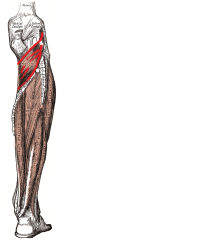
|
Popliteus- Location: Behind the knee; Function: unlocks and contracts the knee |
|

|
Tibialis Posterior- Location: is the most central of all the leg muscles, and is located in the posterior compartment of the leg; Function: Prime mover of foot inversion |
|
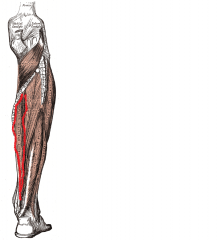
|
Flexor Digitorum Longus- Location: Posterior and inner lower leg; Function: Long muscle that flexes toes |
|

|
Flexor Hallucis Longus- Location: on the tibial side of the leg. At its origin it is thin and pointed, but it gradually increases in size as it descends; Function: Long muscle that flexes the Big Toe |
|
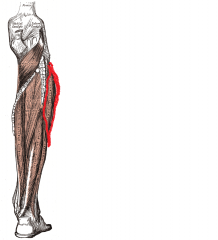
|
Fibularis Longus- Location: a superficial muscle in the lateral compartment of the leg; Function: Plantar flexion and eversion of the foot. |
|

|
Tibialis Anterior- Location: a muscle that originates in the upper two-thirds of the lateral (outside) surface of the tibia; Function: Dorsiflexion- points toes up |
|

|
Extensor Digitorum Longus- Location: situated at the lateral part of the front of the leg; Function: Extends your toes |
|

|
Extensor Hallucis Longus- Location: a thin muscle, situated between the Tibialis anterior and the Extensor digitorum longus; Function: Extends the Big Toe |

